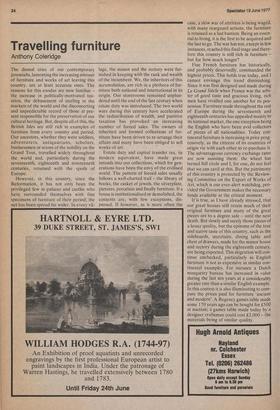Travelling furniture
Anthony Coleridge
The dismal cries of our contemporary jeremiahs, lamenting the increasing amount of furniture and works of art leaving this country, are at least accurate ones. The reasons for this exodus are now familiar — the increase in politically-motivated taxation, the debasement of sterling in the markets of the world and the disconcerting and unpredictable record of those at present responsible for the preservation of our cultural heritage. But, despite all of this, the British Isles are still rich in examples of furniture from every country and period. Our ancestors, whether they were soldiers, adventurers, antiquarians, scholars, businessmen or scions of the nobility on the Grand Tour, travelled widely throughout the world and, particularly during the seventeenth, eighteenth and nineteeneth centuries, returned with the spoils of Europe.
However, in this country, since the Reformation, it has not only been the privileged few in palaces and castles who have surrounded themselves with fine specimens of furniture of their period; the net has been spread far wider. In every vil
lage, the manor and the rectory were furnished in keeping with the rank and wealth of the incumbent. We, the inheritors of this accumulation, are rich in a plethora of furniture both national and international in its origin. Our storerooms remained unplundered until the end of the last century when estate duty was introduced. The two world wars during this century have accelerated the redistribution of wealth, and punitive taxation has provoked an increasing number of forced sales. The owners of inherited and formed collections of furniture have been driven to re-arrange their affairs and many have been obliged to sell works of art.
Estate duty and capital transfer tax, its modern equivalent, have made great inroads into our collections, which for generations have been the envy of the civilised world. The pattern of forced sales usually follows a well-charted trail — the library of books, the casket of jewels, the silverplate, pictures, porcelain and finally furniture. If a house is institutionalised or demolished, the contents are; with few exceptions, dispersed. If however, as is more often the case, a slow war of attrition is being waged, with many rearguard actions, the furniture is retained as a last bastion. Being an essential to living, it is the first to be acquired and the last to go. The war has not, except in few instances, reached this final stage and therefore this country is still rich in furniture — but for how much longer?
Fine French furniture has historically, and probably deservedly, commanded the highest prices. This holds true today, and I cannot envisage this trend diminishing. Since it was first designed and made during Le Grand Siècle when France was the arbiter of good taste and gracious living, rich men have rivalled one another for its possession. Furniture made throughout the rest of Europe during the seventeenth and eighteenth centuries has appealed mainly to its national market, the one exception being the English who have been avid collectors of pieces of all nationalities. Today continental furniture is increasing in price progressively, as the citizens of its countries of origin vie with each other to re-purchase it. The advantageous currency exchange rates are now assisting them: the wheel has turned full circle and I, for one, do not feelthat we can cavil at this. But the patrimony of this country is protected by the Reviewing Committee on the Export of Works of Art, which is our ever-alert watchdog, provided the Government makes the necessary funds available at the critical moment.
It is true, as I have already stressed, that our great houses still retain much of their original furniture and many of the great pieces are to a degree safe — until the next death. But slowly and surely those pieces of a lesser quality, but the epitome of the true and native taste of this country, such as the sideboards, secretaire, dining table and chest of drawers. made for the manor house and rectory during the eighteenth century, are being exported. This migration will continue unchecked, particularly as English furniture is not as expensive as similar continental examples. For instance a Dutch marquetry bureau has increased in value during the last ten years at a considerably greater rate than a similar English example. In this context it is also illuminating to compare the prices paid for furniture 'ancient and modern'. A Regency games table made some 170 years ago can be bought for £500 at auction; a games table made today by a designer craftsman could cost £3,000 — the materials being of similar quality.


































 Previous page
Previous page